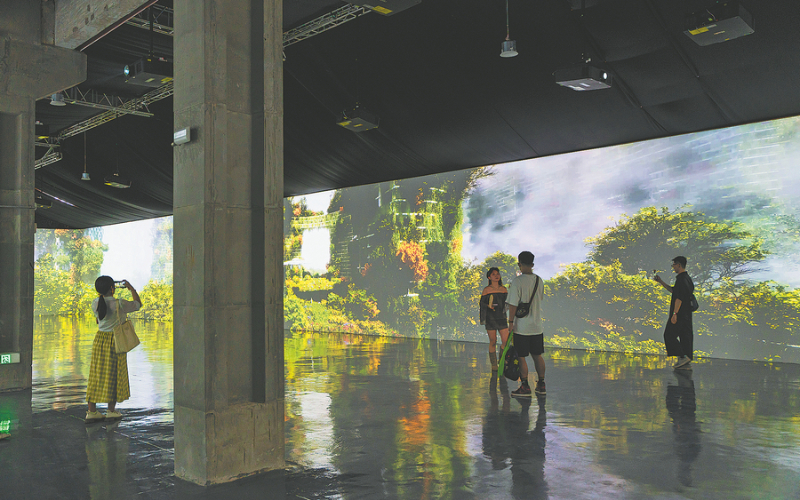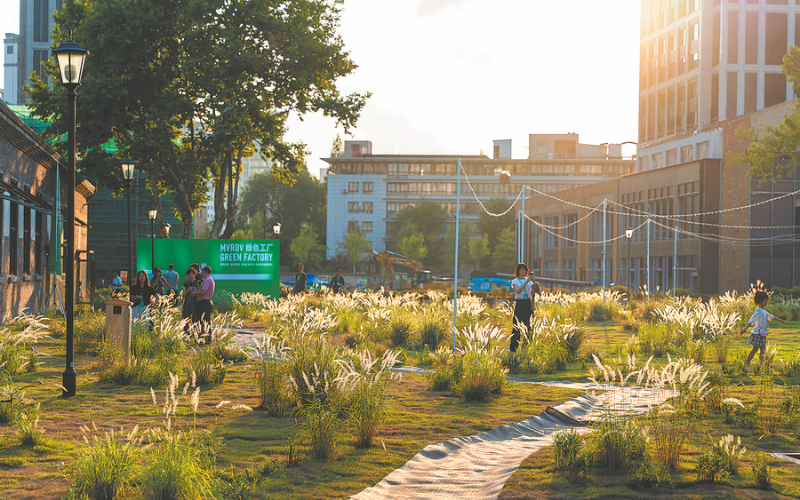Clean, green and serene

An immersive film at the exhibition presents to the visitors what cities could look like with abundant vegetation. CHINA DAILY
Sneak peek of Hangzhou's new cultural cluster reveals city has sights set on becoming regional urban template, Cheng Yuezhu reports.
For decades, the oxygen plant in Hangzhou, Zhejiang province, was a symbol of the city's industrialization and economic development. Sprawling over more than 60 hectares, the vast complex is now taking on a brand-new existence.
In accordance with changing requirements for urban development and industrial upgrading, the factory has been moving operations to more suburban areas of the city since 2008. Now, the municipal government has decided to repurpose the site and make it an international platform for promoting culture and tourism.
Part of this involves the creation of the O2 Museum, comprising an urban museum as well as an art and science museum. Although it is scheduled to open officially next year, it recently offered visitors a sneak peek of what to expect with an exhibition and accompanying series of forums.
Two of the site's former factory buildings have been surrounded by flower-filled meadows, making them an ideal spot to relax in the early autumn breeze.
As visitors enter the exhibition, MVRDV Green Factory, they find the exhibition hall is also covered in greenery, and a banner at the entrance greets them with the words: "Welcome to the green city".
Running until Dec 31, the exhibition is about the work of Dutch architectural firm MVRDV, with a particular focus on the Green Dip research project undertaken by The Why Factory, a think tank set up by the Dutch firm's founding partner, Winy Maas.
Explaining the Green Dip concept, Maas uses the analogy of dipping ice cream in chocolate to enhance its flavor.
"I imagine cities being dipped in greenery to make them better. I have always dreamed that cities could be like that in the future, maybe Hong Kong, maybe Beijing, maybe Hangzhou," Maas said during his speech at the opening ceremony of the exhibition.
With scale models, descriptions, images and an immersive film, the exhibition presents an overview of the work The Why Factory has undertaken to turn its vision of transforming cities with greenery into reality.
The film presents a vivid preview of the green cities Maas proposes, and focuses on the outdoor areas, building surfaces and indoor spaces of five cities, all cloaked in trees and plants, with their landmarks retained.
To turn these images into reality in a practical manner, The Why Factory has been developing the Greenmaker tool, which, through meticulous calculation, designs reinforced structures that permit vegetation to grow throughout buildings, thus contributing to carbon neutrality. Projects ranging from individual buildings to the planning of urban areas have been carried out achieving the "green reality" Maas envisions.
Since 2000, the Dutch architectural firm has been involved in projects in several major Chinese cities including Beijing, Shanghai and Hangzhou.
The current Hangzhou project dates back to 2019, when Maas and Weng Ling, art curator and founder of the Beijing-based cultural company IDEAS, worked on the master plan for a demonstration area in the northern part of the city near the Beijing-Hangzhou Grand Canal, where the former oxygen plant is located.
"Our urban planning projects integrate the IDEAS concept — the integration and innovation of art and science to create an ideal future for people, cities and nature," Weng says. "We are blending different forms of art and creative expression, as well as interdisciplinary creation and presentation, into an envisioned future space."
In tandem with the exhibition, a series of IDEAS Envisioning the Future forums took place between Sept 15 and 17, drawing experts from fields including design, education, art and science.

Two of Hangzhou's former oxygen plant buildings in Zhejiang province are surrounded by flower-filled meadows. CHINA DAILY
Covering topics ranging from art and science, and the power of art and design, to innovation for good, and humanity and lifestyle, guest speakers discussed popular contemporary topics, as well as ways to facilitate the creation of future societies and urban construction in creative and innovative ways.
Weng spoke of her affinity for Hangzhou's natural elegance, which she said represents Chinese aesthetics. However, despite the city's many advantages, she feels that it is still lacking in terms of contemporary urban culture.
By inviting dozens of internationally known artists, architects and scientists to Hangzhou for an intense two-day session, the aim of the event was to bring international vision, an open attitude and a wealth of resources to the city.
"We hope that the invitees will bring us new ideas, methods and references," Weng says, adding that in the future, forums and lectures will be hosted in the revamped spaces, and experts from all over the world will be invited to speak, to infuse new vitality into the city.
The two buildings unveiled to the public at the recent event are a fraction of the entire site. Once the remaining spaces are opened, Weng says, they will hopefully serve as a platform for young people.
"I hope that all our projects lay a foundation for the young, and that they will perceive this project as a platform they can use. It is my belief, and also the nature of history, that the young stand on the shoulders of their elders to reach even greater heights," Weng says.
Earlier this year, MVRDV won a competition to revamp Hangzhou's former oil refinery with plans to transform the industrial area into an art and science center. The project envisions the creation of office spaces, retail outlets and a variety of cultural experience spaces, including ones that celebrate the site's industrial heritage, set in greenery along the Grand Canal.
"We plan to cover everything in solar panels, to create a kind of solar energy park, and illustrate the transformation of energy from the fossil fuel to the post-fossil fuel era," Maas says.
"And with such an abundance of energy, we can light the park, and create spectacles for free. It's this kind of liberation that I would like to symbolize in the park," Maas adds.
Many other transformation projects are already underway in the industrial areas along the Grand Canal in Hangzhou under the aegis of internationally renowned architects including Kengo Kuma, Liu Jiakun and Ma Yansong, and architectural firms such as Herzog & de Meuron.
"The area is connected to the Grand Canal, right next to one of its branches. The Grand Canal has a significant impact on the surrounding region, so we are hoping to use these projects along it to establish Hangzhou as a model for future Asian cities," Weng says.
Contact the writer at chengyuezhu@chinadaily.com.cn


